
Published September 7, 2025
A devastating 6.0-magnitude earthquake struck eastern Afghanistan on August 31, 2025, leading to a catastrophic humanitarian crisis. The epicenter was in the remote Dewagal Valley of Kunar Province, where steep terrain and mud-brick homes left communities particularly vulnerable. The quake claimed over 2,200 lives, with entire families perishing and entire villages reduced to rubble. The United Nations estimates that approximately 500,000 people, more than half of them children, have been affected by the disaster.
Survivors’ Struggles and Devastation
Survivors like Ahmad Khan Safi and Ghulam Rahman have lost not only family members but also their homes and livelihoods. Safi alone lost 22 relatives and 300 livestock, while Rahman buried much of his family on donated land. Infrastructure, including roads, bridges, schools, and water sources, was destroyed, displacing many and raising urgent health concerns. Torrential rains and landslides have exacerbated the situation, making survival increasingly difficult for those now living in the open.
Aid Efforts and International Response
International aid organizations are struggling to reach survivors due to the mountainous terrain and landslides. Some workers are hiking for hours into isolated villages, while relief efforts are further hampered by severe funding shortages. The Norwegian Refugee Council, for instance, reports a drastic reduction in resources and personnel since 2023, with only $100,000 currently available for emergency aid against a $2 million needed.
In a notable diplomatic gesture, Qatar’s Minister Maryam Al Misnad became the first female minister to visit Taliban-controlled Afghanistan since 2021, overseeing the delivery of humanitarian aid.
👥 Public/Political Reactions
🇦🇫 Domestic Response
In the aftermath of the devastating earthquake, Afghan survivors have expressed profound grief and frustration. Many have lost family members, homes, and livelihoods. For instance, in Kunar province, entire villages were flattened, and survivors are left without adequate shelter or medical care. The Taliban government has appealed for international humanitarian aid, acknowledging the scale of the disaster and the limitations of their resources. However, internal challenges, including restrictions on women’s participation in aid efforts, have further complicated the response.
🌍 International Reactions
United States
The U.S. government’s response has been a subject of significant concern. Despite being a former major donor to Afghanistan, the U.S. has not authorized emergency aid nearly a week after the earthquake. This inaction follows the Trump administration’s decision to end nearly all humanitarian aid to Afghanistan, citing concerns over funds potentially benefiting the Taliban. As a result, essential medical supplies and relief materials remain stuck, awaiting approval.
United Nations and Other Countries
The United Nations and various countries have stepped in to provide assistance. The UN has warned that the humanitarian situation is dire, with the earthquake exacerbating existing crises in the country. Countries such as Iran, India, the United Kingdom, China, and Qatar have pledged aid, including medical supplies, food, and shelter materials. Notably, Qatar’s Minister Maryam Al Misnad became the first female minister to visit Taliban-controlled Afghanistan since 2021, overseeing the delivery of humanitarian aid.
🧭 Humanitarian Challenges
The ongoing humanitarian efforts face numerous challenges. The mountainous terrain of the affected regions has hindered access, making it difficult for aid to reach those in need. Additionally, the lack of female rescue personnel has made it harder for women and children to receive necessary care, especially in conservative areas. Furthermore, the Taliban’s restrictions on women’s participation in aid efforts have limited the effectiveness of the response.
 Resulting Effects
Resulting Effects
The 6.0-magnitude earthquake in Kunar Province, Afghanistan, has triggered a cascade of humanitarian, infrastructural, and socio-political consequences.
1. Humanitarian Impact
-
Casualties and Injuries: Over 2,200 people have died, with thousands more injured. Entire families perished, leaving survivors traumatized.
-
Displacement: Approximately 500,000 people have been affected, many of whom are now living in temporary shelters or makeshift tents.
-
Health Crisis: Limited access to medical facilities and supplies has heightened risks of disease outbreaks, dehydration, and malnutrition, especially among children.
2. Infrastructure Damage
-
Destruction of Homes: Mud-brick homes in rural Kunar Province were flattened, leaving communities without basic shelter.
-
Public Facilities: Schools, hospitals, and local marketplaces were destroyed or severely damaged, hampering access to education, healthcare, and economic activity.
-
Transportation Barriers: Landslides and damaged roads have isolated villages, making relief efforts extremely difficult.
3. Economic Consequences
-
Livelihood Loss: Many survivors lost livestock, crops, and small businesses, leading to immediate food insecurity and income loss.
-
Agricultural Setbacks: Farmlands damaged by landslides and debris have disrupted seasonal planting cycles, threatening long-term food supply.
4. Social and Psychological Effects
-
Trauma: Survivors face psychological distress, grief, and anxiety from the loss of family and community structures.
-
Community Disruption: Entire villages were destroyed, breaking social networks and support systems that are crucial in rural Afghan society.
5. Humanitarian and Political Implications
-
Aid Shortages: International relief has been delayed by political restrictions, funding gaps, and difficult terrain.
-
Political Criticism: The slow U.S. response and Taliban administrative limitations have sparked criticism from global humanitarian organizations.
-
Gendered Impact: Restrictions on female participation in aid work have limited access to relief for women and children, particularly in conservative communities.
🔮 Future Outlook
The future trajectory of recovery in eastern Afghanistan depends on the interplay of humanitarian assistance, political decisions, and local resilience.
1. Immediate Humanitarian Needs
-
Medical and Shelter Support: Thousands of injured and displaced people still require emergency medical care, temporary housing, and clean water.
-
Nutrition and Food Security: Food shortages are likely to worsen as livelihoods and farmlands were destroyed, creating prolonged vulnerability for children and families.
-
Psychosocial Support: Trauma counseling and mental health services will be essential to help communities cope with loss, grief, and anxiety.
2. Infrastructure and Reconstruction
-
Housing Rebuilding: Reconstructing mud-brick homes and community structures will take months to years, depending on funding and access to building materials.
-
Public Services: Schools, hospitals, and roads need urgent repair to restore essential services and economic activity.
-
Disaster-Resilient Planning: Future construction may need earthquake-resistant designs to mitigate damage from similar events.
3. Political and Security Implications
-
Aid Dependency vs. Local Capacity: With the Taliban controlling access to affected areas, aid distribution may be limited or politicized, affecting equitable relief.
-
International Relations: The U.S. and other major donors’ response—or lack thereof—may influence geopolitical ties and humanitarian credibility.
-
Gender Equity Challenges: Women and children may continue to face restricted access to aid unless policies are adjusted to allow full participation in relief efforts.
4. Long-Term Economic Outlook
-
Livelihood Recovery: Farmers and small businesses will require financial support and agricultural inputs to rebuild income sources.
-
Poverty Risk: Without timely interventions, affected regions may experience long-term poverty and food insecurity, slowing national economic recovery.
-
Aid Reliance: Afghanistan may remain heavily dependent on international aid for reconstruction and social services in the near future.
5. Environmental and Disaster Preparedness
-
Landslide Risk: Ongoing landslides and unstable terrain increase the risk of secondary disasters.
-
Preparedness Measures: Investment in early warning systems and community disaster training is critical to mitigate future earthquake impacts.
 Bottom Line:
Bottom Line:
The 2025 earthquake in eastern Afghanistan has triggered a humanitarian catastrophe with over 2,200 deaths and hundreds of thousands affected. The destruction of homes, schools, hospitals, and roads has left communities isolated and in urgent need of basic services, food, and medical care.
Key Takeaways:
-
Humanitarian Crisis: Survivors face immediate threats from injury, disease, and food insecurity, with children being particularly vulnerable.
-
Infrastructure and Livelihood Loss: Entire villages and farmlands have been destroyed, disrupting both daily life and long-term economic stability.
-
Aid Challenges: Relief efforts are hampered by difficult terrain, political barriers, and funding shortages. Delays from major donors, especially the U.S., have intensified the crisis.
-
Socio-Political Implications: Restrictions on female participation in relief work have limited access to aid for women and children, highlighting structural vulnerabilities.
-
Recovery Outlook: Rebuilding will require coordinated international support, disaster-resilient planning, and inclusive aid policies. Without these, the region may face prolonged hardship and stagnation.
This disaster underscores the urgent need for a timely, coordinated, and inclusive global response to save lives, restore infrastructure, and support Afghanistan’s long-term recovery.
SOURCES: REUTERS – US yet to approve any help following Afghanistan earthquake, sources say
AP NEWS – An earthquake in Afghanistan’s east wipes out homes, generations and livelihoods
AL JAZEERA – Afghanistan earthquake death toll rises to 2,200





Be the first to comment